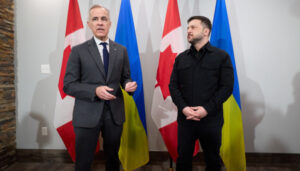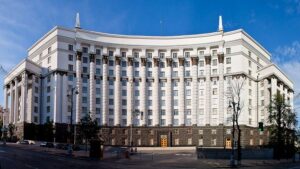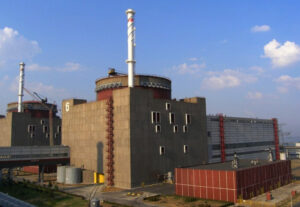
Canadian Prime Minister Mark Carney announced additional economic assistance to Ukraine in the amount of 2.5 billion Canadian dollars, which will help unblock funding from the IMF, the World Bank, and the European Bank for Reconstruction and Development.
“Today we are announcing additional economic assistance to Ukraine. Economic assistance in the amount of $2.5 billion. This will help unlock funding from the IMF, the World Bank, and the European Bank for Reconstruction and Development to start this recovery process,” Carney said at the beginning of his meeting with Ukrainian President Volodymyr Zelensky.
In turn, Zelensky thanked Carney for his help and stressed the need to stop the war.
“And for this, we need two things: pressure on Russia and sufficiently strong support for Ukraine,” the president said.
He said he plans to discuss strengthening air defense with Carney.
“In recent weeks, we have made good progress in diplomacy, but we cannot live under the illusion that this allows us to have less air defense. It doesn’t work with Russia,” Zelenskyy said.

Yulia Savostina, founder of the Made in Ukraine project, volunteer, and expert on intangible cultural heritage at the Office for Support of Recovery at the Ministry of Culture and Strategic Communications, has become head of the Re-Inform news agency under the Ministry of Social Policy, Family, and Unity of Ukraine.
“I will try not only to use my managerial skills and creativity, but also to establish communication with Ukrainians abroad, trying to reach the most remote places in the world where the great war has scattered us,” Savostina wrote on Facebook on Friday.
According to her, Re-Inform will maintain contact with Ukrainians abroad, inform them about social programs in Ukraine, “explain what is happening at home so that people in Paris, Warsaw, and Toronto do not think that we are just sitting here without electricity; it will combat misinformation and disinformation.”
“The work is difficult and important. Because Ukrainians around the world need to know that they are expected and remembered here. And that Ukraine is not only about war and survival, but also about work, development, opportunities, and life,” Savostina wrote.
She thanked the Minister of Social Policy, Family, and Unity, Denys Ulyutin, “for the offer and trust” and noted the support of the Deputy Minister for European Integration, Ilona Gavronska.

Vadym Honcharenko, a student at Kyiv National University of Construction and Architecture and a veteran, has joined the Ukrainian national team that will represent the country at the Air Force and Marine Corps Trials international veterans and military competition in the United States in 2026. This was reported by the Come Back Alive Charitable Foundation’s Center for Initiatives.
Based on the results of the selection process, 15 veterans—winners of the All-Ukrainian Defense Forces Competition “GART”—joined the team.
The formation, preparation, and participation of the Ukrainian team in international competitions are carried out jointly by the Ministry of Veterans Affairs of Ukraine and the Come Back Alive Initiative Center.
The Air Force and Marine Corps Trials are international adaptive competitions for military personnel and veterans, which are an official stage of selection for the Warrior Games. They are held annually in the United States and bring together participants from around the world, becoming an important element of the international sports and rehabilitation movement for veterans.
Vadym Honcharenko’s sporting achievements
Throughout 2025, Vadym Honcharenko demonstrated results in a number of adaptive and strength sports. He became the Ukrainian champion in para-arm wrestling and also represented Ukraine at the European Championships.
Throughout the year, Vadym repeatedly participated in functional and team sports competitions, including the Spartan Race, marathons, rugby, and CrossFit competitions. In November, he won the Zvytyaga Nezkonenyh (Victory of the Unconquered) strongman competition among military personnel and veterans, taking first place in several strength disciplines. The end of the year was marked by new prize places in rowing, powerlifting, and strongman multi-event competitions.

Former owner of English football club Chelsea Roman Abramovich has blocked the transfer of money to Ukraine from the sale of the club in 2022, despite an ultimatum from British Prime Minister Keir Starmer, The Times reports.
The funds, amounting to approximately £2.3-2.5 billion, received from the sale of Chelsea to a consortium of investors, remain frozen in UK accounts due to sanctions imposed on Abramovich after Russia’s full-scale invasion of Ukraine.
Starmer is officially demanding that the businessman transfer the entire amount to humanitarian causes to help Ukraine. He said the government had issued a special license to transfer the funds and was prepared to go to court to enforce the obligations.
However, Abramovich has refused to comply with this demand. According to The Times, he rejected the ultimatum and initiated preparations for legal defense, engaging high-profile lawyers, including a former White House adviser, to defend his position.
According to Abramovich’s representatives, he believes he has legal grounds to challenge the transfer of funds on the terms proposed by London. In particular, he insists that the money should be distributed not only to Ukraine, but also to “potentially other victims of the war,” which is met with objections from the British government and the EU.
The UK government insists that the funds should be used exclusively to help Ukraine and continues to put pressure on Abramovich through political and legal mechanisms.

The Cabinet of Ministers has authorized the sale of over-the-counter drugs at gas stations, provided that the appropriate license is obtained, according to Health Minister Viktor Lyashko.
“We have authorized the sale of over-the-counter drugs at gas stations, provided that the appropriate license is obtained. This applies to situations where there are no pharmacies nearby: in villages, in frontline communities, or late at night outside of large cities. We are only talking about safe, over-the-counter drugs that people use on their own. In wartime, this is especially important, as gas station chains often remain operational even during power outages. The requirements for sales at gas stations ensure the quality and safety of medicines. This will help lower prices and make medicines more affordable,” he wrote on Facebook.
According to him, the government has also made a number of decisions, in particular, pharmacies in state and municipal hospitals are required to sell only the three lowest-priced drugs from the National Catalog among drugs with the same composition and effect.
In addition, specialists with a broader range of qualifications, as defined by law, can now be employed in pharmacies and pharmacy outlets.
“In rural areas and frontline communities, medicines can be dispensed in pharmacies (without manufacturing) by specialists with at least a junior bachelor’s degree in nursing and a certificate in pharmacy (retail sale of medicines). This allows pharmacies to build more effective teams, especially in communities with staff shortages, while ensuring the quality and safety of pharmaceutical care for patients,” Lyashko wrote.
In addition, the government has regulated the rules for providing marketing services in the pharmaceutical sector.
“This refers to transparent tools for promoting drugs at points of sale: providing information, placing materials, or participating in loyalty programs. The launch of the National Price Catalog makes it impossible to use marketing as a tool for covertly increasing the cost of drugs—the declared prices are fixed, and promotion becomes a mechanism for informing and increasing accessibility for patients,” the minister noted.

Important repair work has begun on power lines near the Russian-occupied Zaporizhzhia NPP following another local ceasefire brokered by the IAEA, the agency said in a post on social media on Sunday.
“Grossi thanks both sides for agreeing to this new temporary ‘window of silence’ to restore power transmission between the ZNPP and Zaporizhzhia Thermal Power Plant distribution stations, which will help strengthen nuclear safety,” the agency wrote.
It is noted that the IAEA team is monitoring the repair work, which is expected to take several days.
Since the start of the Russian occupation on March 4, 2022, the ZNPP has repeatedly experienced complete and partial blackouts due to the loss of all power lines (it receives electricity from the Ukrainian power grid), with the launch of emergency diesel generators and safety systems, the failure of which could lead to an emergency situation.
According to the IAEA, before the war, the ZNPP had 10 power lines — six at 750 kV and four at 330 kV. The largest nuclear power plant in Europe, which has six 1 GW units, has not been producing electricity since September 11, 2022, following the occupation.
The issue of the ZNPP is one of the problematic ones in the negotiations on the possibility of a peace agreement between Ukraine and Russia, mediated by the US. According to Ukrainian President Volodymyr Zelenskyy, Washington is proposing that the plant in the currently occupied city of Enerhodar in the Zaporizhzhia region be jointly managed by the US, Ukraine, and Russia in a 33%:33%:33% split, while Ukraine is proposing that the plant be operated by a joint venture consisting of 50:50%
IAEA, POWER LINE, REPAIR, truce, ZNPP